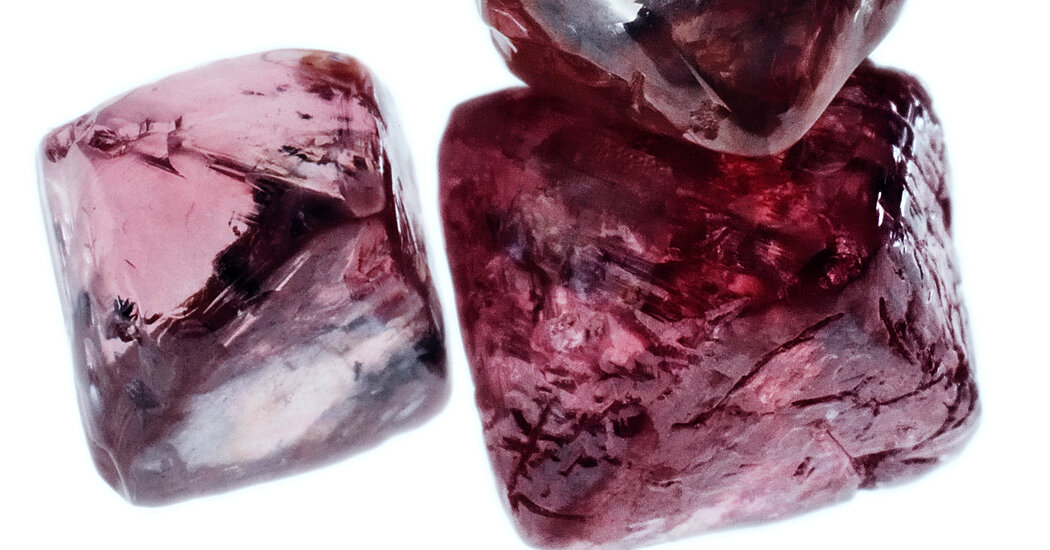Pink diamonds take the Barbiecore craze to another level, but the rosy color comes at a cost. These gems are among the most rare and valuable diamonds around. And they’re far from perfect.
“They’re actually damaged diamonds,” said Hugo Olierook, a geoscientist at Curtin University in Perth, Australia.
The color comes from the warping of the gem’s crystal lattice under intense pressure. While all diamonds form under pressure, even more force turns once clear diamonds colorful. A slight extra squeeze turns a diamond pink, and a hard squash turns it brown.
More than 90 percent of the pink stones ever found came from the Argyle mine in Western Australia, which was one of the world’s most productive diamond deposits until it ceased operations in November 2020. Many of Argyle’s diamonds have a chocolatey brown or tawny hue. But out of every thousand gems, a couple would pop up in the rarer and more valuable pink.
Now Dr. Olierook and his colleagues have a new estimate for when and how these gems arrived on Earth’s surface. In a study published Tuesday in the journal Nature Communications, they reported that some 1.3 billion years ago, the blushing and brown stones were pushed through the relatively thin continental edges during the demise of Nuna, one of Earth’s earliest supercontinents. If confirmed, the work hints at the possibility that ancient continental junctures may be hiding more of these colorful gems.
The diamonds that would emerge at Argyle formed deep underground, near the stable continental roots. As landmasses smashed together to form Nuna, collisions near Australia’s northwestern edge provided the pressure needed to color the once-colorless gems.
In the late 1980s, a team led by Robert Pidgeon, now an emeritus professor at Curtin, found that Argyle’s diamond-studded volcanic rocks erupted roughly 1.2 billion years ago. During that period, there were few obvious tectonic triggers for explosive eruptions that could bring Argyle’s diamonds up from the deep.
“Australia at that point was floating happily through the oceans,” Dr. Olierook said.
But Dr. Pidgeon had long questioned his own findings. The eruption that generated Argyle’s diamond haul blasted through an ancient lake, which altered the rocks, potentially affecting the accuracy of the dating estimate. He mentioned the concern in a casual hallway conversation with another author of the study, Denis Fougerouse of Curtin University, who assembled a team to take a closer look.
The researchers produced a new estimate of the age of the Argyle rocks using a laser beam that was finer than a hair’s width. Their analysis suggests that the eruption happened roughly 1.3 billion years ago — about 100 million years before Dr. Pidgeon’s estimate.
The new date coincides with the time when Nuna began to splinter, thinning along the geologic sutures where earlier continents had collided, Dr. Olierook said. This thinning likely helped diamond-studded magma shoot to the surface near the edge of what is now northwestern Australia.
The broad link between continental rifting and diamond deposits is not a new idea, but the details are debated. A recent modeling study suggests that supercontinent breakup could trigger churning currents in the Earth’s mantle that send diamond-rich eruptions punching through its crust.
These currents likely ripple inland over time, which could help explain why most diamond-rich eruptions blast through thick continental interiors. Yet the Argyle diamonds, which erupted near the continental edge, may represent an early phase of this process before the eruptions marched inland.
The new study is an important step toward deciphering the “perfect storm of conditions” that helped create Argyle’s colorful gems, said Thomas Gernon, a geologist at the University of Southampton in England who has studied how diamonds are shaped by supercontinent splits.
Yet some questions remain. “This is the last part of the story,” said Steve Shirey, an isotope geochemist at Carnegie Science in Washington, D.C., who was not part of the study team. For example, he wonders why so much carbon had collected to create Argyle’s abundance of diamonds in the first place.
David Phillips, a geochemist at the University of Melbourne, points out that the new age range for Argyle could be further narrowed. “The conclusions of this study might be correct, but in my opinion, this remains an open question,” he said.
Dr. Gernon emphasized that understanding such an ancient system is no simple undertaking. And one thing is for sure, he said: “Nature always throws up surprises.”











